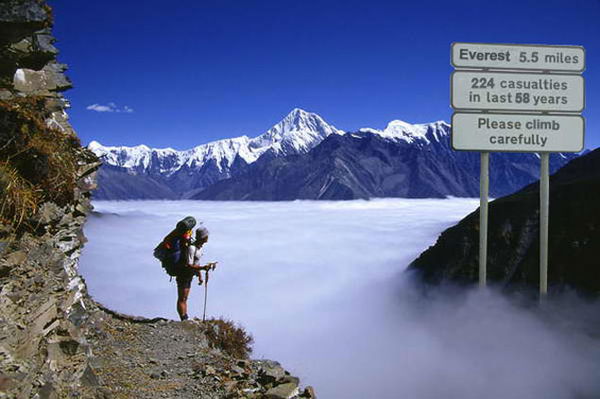Mount Everest vs. The Isle of Man TT
A few thoughts for your consideration


Every year the topic of banning the TT comes up but did you know that the average deaths per year on Mount Everest are higher than the TT?
Social commentators and ill-informed journalists who think that the world should be a place where no-one is allowed to die of anything except old age put their tuppence in every time there's a death at the TT but it's not just the Daily Mail-reading stereotype that dabbles in a bit of anti-TT either; I hear more and more bikers talking about it too.
It struck me the other day that the TT is one of those great feats of human endurance and when I think of the feat of human endurance; it's those who try and reach the peak of Mount Everest.
Despite huge advances in technology, climbing Mount Everest remains one of the signatures of what makes us human. A massive feat that pushes the people who try it to the limit of their own mental and physical endurance and often beyond.
A lot has changed since George Mallory and Andrew Irvine died while trying to reach the peak in 1924. Today, the technology used in clothing, for navigation and the knowledge of the ascent built-up over the years means that climbing Everest is now safer than ever. It is however, far from being safe.
In 1953 Edmund Hillary, a New Zealand beekeeper, and Tenzing Norgay, an acclaimed Sherpa became the first to reach the roof of the world, 15 people before them had died trying. Since Hillary and Norgay climbed to the summit, over 2700 people have made it to the top, however 224 people have died trying, too.
That's one person dying for every 12 who have climbed to the top of Mount Everest.
By comparison, the first Isle of Man TT race took place in 1907. The race was won by Charlie Collier at an average speed of 38.21 mph. Today a lot has changed about the TT including the lap record - which stands at 131.58mph - set by John McGuinness in 2009 on a Honda Fireblade. In 2009's Superbike TT, John McGuinness rode the 6 lap race in 1 hour, 46 minutes and seven seconds. His total distance? 226.38 miles at an average speed of 127.996mph. That's worth reading again. Two-hundred and twenty-six miles around closed roads at an average speed of one-hundred and twenty-seven miles an hour. It's a feat of endurance that makes the hairs on the back of my neck stand up.
The first person to die on the TT course was Victor Surridge in 1911 (also the first person to die on the Isle of Man in an automotive accident). In its 104 year history, 134 riders have died on the TT course, that's an average of 1.34 deaths a year. The average yearly death toll for Everest stands at 2.52 per year since 1924. However it was only after Hillary made the first successful ascent in 1953 that climbing Everest became a reality and the numbers of people attempting it dramatically increased. Since 1953, 211 people have died trying to climb Everest - that's a death rate of 3.6 people per year.
Now, all this talk of dying is very morbid and takes us away from the real reason both of these challenges remain so aspirational to so many: to climb to the highest point in the world, avoiding avalanches, ferocious storms and battling 100mph sub-zero winds could be argued as being utterly pointless. Afterall, it's been done before, you don't win anything for doing it again and yet by climbing Everest you are undoubtedly satisfying a deep-down urge to prove yourself against the elements. It's you versus The World.
When someone dies on Everest, their passing is a less brutal one than at the TT, they're hundreds of miles away from TV cameras, sponsorship deals and twitching curtains but they die none the less. Often they're left on the mountain and some of the bodies are now used as navigation points for others to pass on their way to the top. It's ruthless but that's the life accepted by those who want to live it at the edge, is it not?
Nevertheless, at the TT just like at the base camp of Everest, each person takes on the challenge knowing the full consequences. Both riders and climbers know the risks and do everything they can to minimise them. However, in order to reach their life's goal they have to face the ultimate risk but that's how they want to live. It's their life, their choice. Who are we to argue with that?
The TT and Everest: both amazing feats of human endurance that attract those who are prepared to feel the fear and do it anyway.
So the next time someone takes an easy pop at the TT, ask them why they don't want to ban the climbing of Everest instead? Afterall, it's at least twice as dangerous.
If you like my thinking please 'Like' this article to help share it.











